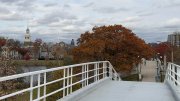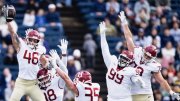There are some ways in which Harvard College, for all its history and prestige, is a normal college with normal students. The undergraduates are interested in their studies. They're concerned about careers after graduation. (They watch the fluctuations in the economy and hope there will be careers after graduation.) They try, with varying degrees of success, to have romantic interests and social lives. But there are some ways in which Harvard is not a normal college with normal students. For example, do Harvard students care about their football team?
That's the question Steve Staples asked himself three years ago, when he arrived from Utah State to become the assistant athletic director at Harvard. "The first thing I saw was that there was very little student support for sports teams," Staples says. "There might have been 130 students at the first football game in 1997. I thought, 'What's going on here?'" And it wasn't just football, he discovered. For the most part, Harvard's 41 varsity teams, male and female--to say nothing of the junior varsity and intramural teams--were performing for empty arenas. Concerned about the effect this might be having on Harvard athletes and on Harvard in general, Staples decided to sit down with a few students and talk about school spirit. "There's got to be more to Harvard than going to class and getting your degree," he says. "I really think rallying behind your athletic teams adds something to the undergraduate experience."
Katie Duffy '01, a JV volleyball and lacrosse player, shared his concerns. "I've played at games when no one, I mean no one, is there," she says. "It's disheartening for the players." So when Duffy noticed a poster advertising a new student group aimed at boosting school spirit, she decided to join the discussion. What grew out of those talks was the H-Club, a year-old organization dedicated to increasing student turnout at home games and overall support for the athletic teams. The H-Club posts information about athletic events at Harvard and offers attendees door prizes from local merchants. It also sponsors tailgate parties, buses to big "away" games, and "Midnight Madness"--food and late-night fun to kick off the hockey season. The club has had an impact, says Duffy, the current president. Almost 1,200 people attended 1999's first football game, compared to about 300 last year. "There's no better feeling than being at a game and hearing '10,000 Men of Harvard,'" Duffy says. "I get goosebumps every time. A lot more students here should be aware of that feeling."
At one time, they were. The H-Club is a recent development in Harvard history, designed as a response to new pressures on college athletics. Televised professional sports are more accessible than ever and more likely to attract viewers than a local college game. An explosion in student activities during the past 20 years has put more demands on undergraduates' time. But 50 years ago, the idea of "school spirit" was very different--and a group like the H-Club wasn't necessary.
A 1941 letter to the Harvard Alumni Bulletin captures the type of "school spirit" then in vogue: "[T]he mass meetings held in the Varsity Club Quadrangle on the evenings before several of the games, preceded by the parade with the Band through the Yard and among the Houses--proved beyond any doubt how solidly the student body was behind this team," wrote Richard C. Floyd '11. "The singing and cheering...was immense. If this is the so-called 'rah-rah stuff,' then I'm frankly for it one hundred percent."
It's pretty hard for current undergraduates to imagine all that fuss over a football game. But, as Warren "Renny" Little '55 remembers, such outpourings of affection weren't always unusual. "There wasn't a booster club because everyone went to the games," he says. "There was a good deal of spirit just naturally--perhaps it was because we didn't have as much to do as [students] do now." There was also an extensive network of support for athletes--including the Crimson Key (originally organized to meet and greet varsity athletes at the start of the school year). The Varsity Club (located in what is now part of the Barker Center) was the locus for athletic support and activity. "You became a member as soon as you got a varsity letter," Little explains. "We took our meals together there and worked out, and there were dances organized for us. We were really rather pampered."
But there were ebbs and flows in student interest even in those days, he admits. "The 1940s and 1970s were troubling times for sports--funding was low and student interest was elsewhere." John Bethell '54, author of Harvard Observed, a history of twentieth-century Harvard, cites political and economic challenges to student spirit in the 1930s and '40s. "During the Depression years the teams didn't do as well, students didn't have as much time or money to spend on sport-related activity, and in the aftermath of World War II it all may have seemed a little childish," he says. "I think the peak of Harvard spirit might actually have been just before World War I."
School-spirit groups aren't the only College organizations to see interest ebb and flow over the years. A more recent example can be traced through the life and death of ethnic publications at Harvard. The number of students of color on campus has increased exponentially since the 1950s and 1960s. Incorporating these students into the life of the University has proven a continuing challenge, and the students themselves have responded with concern about how their voices are represented. Publications, perhaps the easiest way to spread a message to fellow undergraduates, have captured the concerns and desires of these students since the formative period of the 1960s.
The first time that Harvard had a population of minority students large enough to mount such an effort was in 1965, when the Journal of Negro Affairs became the very first black-focused periodical published on the predominately white campus. It was also the best, according to Thomson professor of government emeritus Martin Kilson, Ph.D. '59, who, along with now senior associate dean Archie Epps III, B.D. '61, mentored the students who produced the Journal. "The essays exhibited a certain intellectual bite-and-thrust," writes Kilson in his forthcoming memoir. "And the students who produced and managed the Journal were such fascinating and loyal troopers for Black folks' honor." A number of them, including Robert Hall '69, Lee Daniels '71, L '74, IOP '93, and Charles Beard '66, J.D. '69, went on to successful careers in the fields they wrote about, academia and politics.
The civil-rights struggles of the 1960s and 1970s provided plenty of material. "It was a seminal time in politics for black people," Epps says. "But there were so many different outlooks--from the NAACP to the burgeoning Black Power movement--that conflict arose about what goal the Journal was supposed to serve." The magazine appeared biannually until 1972, when political differences within the staff and lack of funding forced it to fold.
Today, as the numbers of Asian, Latino, and Native American students have increased, publications have sprung up to address their concerns. Zalacain, a journal focused on Latin American peoples and the nations of Latin America, debuted last year to great praise from undergraduates. Founding editor Magdalena Edwards '99 was inspired by conversations with classmates and professors about visions of Latin America at Harvard. "Zalacain encourages the notion that Latin America is not only about military dictatorships, World Bank loans, capital inflows, and illegal migration into the U.S.," she says. "Latin America offers diverse cultural, artistic, and literary accomplishments and movements. We felt the Harvard campus could and would (and should) reflect this, and that the magazine would be a good way to connect people interested in the region, whether or not they had much knowledge about it." To that end, Zalacain publishes nonfiction, personal essays, and literary translations.
And just as the political atmosphere of the 1960s affected the Journal of Negro Affairs, the atmosphere of the 1990s has affected publications. Growing awareness that people of color account for two out of every three individuals worldwide has made multiculturalism and racial harmony of greater concern to America, and to Harvard in particular. To that end, the six-year-old Diversity and Distinction publishes fiction, nonfiction, and essays on topics of multiculturalism and diversity that seek to address the needs of racial minorities, gays and lesbians, and the physically disabled. In addition to discussing pressures and prejudices from mainstream America, Diversity and Distinction addresses those needs by tackling issues of prejudice within those groups as well--including elitism and hierarchical privilege based on skin color. "The best way to achieving harmony and tolerance for all is by understanding," wrote founding editor Michael Luo '97 in the magazine's 1995 proposal statement. "Understanding means comprehending the issues, obstacles, and cultures that are pertinent to particular groups of people."
Dean Epps believes the secret to understanding student organizations lies in a 1953 essay called "The Changing Nature of College Groups," by Samuel P. Huntington, Ph.D. '51, now Weatherhead University Professor. "[He says] there are really only six or seven distinct groups in college organizations," Epps points out, "academic, literary, social, athletic, religious, and ethnic. Interest in these different groups changes depending on the era, but they always come back."
Today, Harvard undergraduates are facing a time crunch unlike anything students faced in the past. Academics, of course, have never been easy, and the increased number of students on financial aid means an increased amount of students' time is spent at jobs. Extracurricular activities increasingly take on the aspect of preprofessional training--with time requirements to match. Facing such constraints, most students who still insist on sleeping and eating have to make difficult choices. Duffy, who works two jobs, plays two sports, and administers the H-Club, admits that she has had to pick what she will focus on at Harvard--and sometimes her studies are sacrificed so that she can learn in other ways. "It is hard here, where lives have to be structured and perfectionism is stressed in all you do, but the key lies in one's perspective of perfect," she says. "Time with my friends and doing my extracurriculars can often give me the satisfaction that an A cannot."








